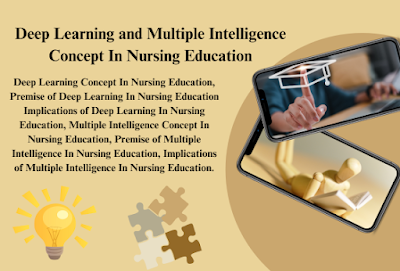The Deep Learning and Multiple Intelligence Concept In Nursing Education. Tactile/kinesthetic learners learn through movement, action, and touch. Multiple intelligences are different ways of demonstrating intellectual abilities.
The Deep Learning and Multiple Intelligence Concept In Nursing Education
Deep learning, a form of artificial intelligence (AI), and Howard Gardner’s theory of multiple intelligences offer unique approaches to improving nursing education and practice. Deep learning can improve decision-making, care planning, and outcome prediction for nurses, while multiple intelligences provide a framework for understanding students’ learning behavior and can tailor educational strategies to individual strengths.
Deep learning in healthcare, a subfield of machine learning, uses neural networks to process unstructured data, such as medical images and text, and is ideal for applications such as image analysis and natural language processing.
The dependent variables were the multiple intelligences of the individual nurses who volunteered as subjects for this study. Multiple intelligences included those defined by Gardner (1993): logical-mathematical, visual-spatial, bodily-kinesthetic, musical, interpersonal, intrapersonal, and verbal-linguistic. In detail, the theory states that we can all understand the world through language, logical-mathematical analysis, spatial representation, musical reasoning, using the body to solve problems or make things happen, understanding other individuals, and understanding ourselves. Three specific learning styles are visual, auditory, and tactile/kinesthetic. Visual learners learn by seeing. Auditory learners learn by listening.
Introduction
Deep Learning and Multiple Intelligence In the evolving landscape of nursing education, adopting innovative learning frameworks is essential for enhancing educational outcomes. Two significant concepts in this regard are Deep Learning and Multiple Intelligences. Understanding and applying these theories can significantly impact how nursing students acquire and apply knowledge, ultimately improving their clinical practice and overall professional development.
Deep Learning in Nursing Education
Concept of Deep Learning
Deep Learning transcends traditional surface learning by emphasizing understanding and meaningful engagement with the material. According to Smith and Colby (2007), Deep Learning involves not just memorizing information but grasping its deeper significance and creating new connections. Unlike surface learning, which is often extrinsically motivated and focused on rote memorization for exams, Deep Learning is intrinsically driven and aims at achieving a profound comprehension of concepts. Whittman Price and Godshall (2009) further distinguish Deep Learning from Strategic Learning, where the latter involves a blend of deep and surface learning strategies tailored towards achieving specific academic goals.
Premise of Deep Learning in Nursing Education
Deep Learning in nursing education is rooted in cognitive and information processing theories. It emphasizes transferring knowledge from short-term to long-term memory through consistent practice and repetition. This approach aligns with the goal of fostering a thorough and enduring understanding of nursing concepts, which is crucial for effective clinical practice.
Implications of Deep Learning in Nursing Education
To cultivate Deep Learning, nursing educators should create environments that facilitate interactive and reflective learning. This includes integrating case studies, simulation exercises, and clinical experiences that encourage critical thinking and problem-solving. Concept mapping and regular self-assessment also play a vital role in helping students develop a conceptual understanding of nursing principles, thereby enhancing their ability to apply knowledge in real-world scenarios.
Multiple Intelligences in Nursing Education
Concept of Multiple Intelligences
Howard Gardner’s theory of Multiple Intelligences (MI) challenges the traditional view of intelligence, proposing that individuals possess various types of intelligences. Initially, Gardner (1983) identified seven intelligences: bodily-kinesthetic, visual-spatial, verbal-linguistic, logical-mathematical, musical-rhythmic, interpersonal, and intrapersonal. Later, naturalist and existential intelligences were added (Bowles, 2008; Moran, Kornhaber & Gardner, 2006). MI theory suggests that people have unique intelligence profiles that influence how they learn and solve problems. This theory encourages educators to consider diverse cognitive strengths rather than focusing solely on verbal-linguistic and logical-mathematical abilities.
Premise of Multiple Intelligences in Nursing Education
In nursing education, the premise of MI is to recognize and nurture the diverse intelligence profiles of students. While certain intelligences may be more dominant in an individual, it is the interplay of these intelligences that enables effective problem-solving and interaction with the environment. The goal is to develop all intelligences holistically to support comprehensive learning and professional growth.
Implications of Multiple Intelligences in Nursing Education
MI theory offers a framework for tailoring instruction to accommodate varied cognitive strengths. Educators can use MI to help students identify and leverage their unique abilities, enhancing their engagement and performance. This approach not only supports academic success but also enriches patient interactions by acknowledging and utilizing diverse problem-solving skills. By focusing on each student’s individual intelligence profile, educators can foster a more inclusive and effective learning environment.
Conclusion
Integrating Deep Learning and Multiple Intelligences into nursing education provides a robust framework for enhancing student learning and clinical practice. Deep Learning encourages profound engagement with material, while Multiple Intelligences recognizes and develops diverse cognitive strengths. Together, these concepts contribute to a more holistic and effective educational experience, preparing nursing students to excel in both their academic and professional careers. By adopting these approaches, educators can create dynamic learning environments that support meaningful and enduring knowledge acquisition.
Read More:
https://nurseseducator.com/didactic-and-dialectic-teaching-rationale-for-team-based-learning/
https://nurseseducator.com/high-fidelity-simulation-use-in-nursing-education/
First NCLEX Exam Center In Pakistan From Lahore (Mall of Lahore) to the Global Nursing
Categories of Journals: W, X, Y and Z Category Journal In Nursing Education
AI in Healthcare Content Creation: A Double-Edged Sword and Scary
Social Links:
https://www.facebook.com/nurseseducator/
https://www.instagram.com/nurseseducator/
https://www.pinterest.com/NursesEducator/
https://www.linkedin.com/in/nurseseducator/
https://www.researchgate.net/profile/Afza-Lal-Din
https://scholar.google.com/citations?hl=en&user=F0XY9vQAAAAJ

11 thoughts on “Deep Learning and Multiple Intelligence Concept In Nursing Education”